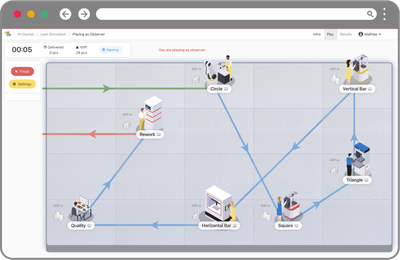What is Value Stream Mapping (VSM)?
With the main objective to deliver value to a customer, Value Stream Mapping (VSM) is a method for mapping product and information flows.
The exact origin of VSM is not precisely known, however some flow representation diagrams appeared in a 1918 book by Charles Edward Knoeppel titled “Installing Efficiency Methods”. As Lean manufacturing techniques became more popular in the 1990s, VSM quickly spread within the Lean community. VSM is now used in many contexts and initiatives.
A value stream map clearly displays all the necessary steps from product manufacturing or development to customer delivery.
Within the manufacturing context, VSM might show the following:
Processing time
Machine setup or changeover time
Available time daily or monthly (depending on production shifts)
Average process defect rate
Average machine downtime or breakdown time
Average number of units on standby/work-in-process between steps
Another goal of VSM is to clearly show all information flows controlling the process, such as ERP orders, scheduling and communication flows with clients and suppliers. The aim is to identify the activities which create value for the client and eliminate or reduce those which do not. The resulting value represents what the client is willing to pay.
Some steps don’t directly bring value, yet must remain in place if they are essential for the successful completion of a delivery overall. One example of this is the process of making sure a product conforms to quality control standards.
Explore the Value Stream Mapping benefits in a simulated Manufacturing environment with the Lean Game
Zensimu's games have already been used by +1000 business, schools & consulting firms to illustrate Supply Chain and Lean concepts.


How does Value Stream Mapping increase a company’s efficiency?
VSM is very useful in many different contexts and particularly valuable within any Lean or continuous improvement initiative because it helps visually identify sources of waste and streamlines and/or synchronizes each step.
For example, in manufacturing, VSM helps reduce the overall time taken between a customer order and delivery while also reducing “work-in-process” inventory. In an office or administrative context, it can be used to redesign the entire process to make it faster, more reliable and to improve user and client satisfaction.
A VSM project requires the following steps:
Identify the project scope. It is usually better to focus on a few similar product lines that approximately follow the same process.
Make sure you have a dedicated team responsible for the Value Stream Mapping project.
Draw up the current state of your VSM. This represents the process as it is today. Don’t hesitate to physically visit the shop floor to accurately visualize and follow all the steps needed for products to be processed.
Collect data about each step. This could be about processing time, available time, waiting time, average inventory, etc. Also indicate the average demand volumes, the frequency of orders received by the client and the frequency of raw material deliveries from suppliers.
Using Lean tools, identify the improvement opportunities which could be included in the process. You may, for example, look at station cycle times vs. TAKT time, add kanban to avoid having too much work-in-process, implement production leveling, pull systems, etc. The goal here is to eliminate waste in the system and favorably move the scale of Value-Adding activities vs. Non-Value-Adding activities.
Design the new, integratable future state VSM. This will be using new symbols such as Kanban, Supermarket, Scheduling Box, Quality Control, etc. You may estimate how the various integrated projects will positively impact inventory, lead time and quality.
Plan and start implementing the various improvements which will make you transition from the current state to the future state. Keep collecting data as this will continue to be useful for evaluating the benefits of the project.
There are several benefits to conducting a VSM project:
It produces a much clearer picture of the process. It helps you quickly evaluate your capacity to fulfill client demand and identify improvement opportunities.
Working on a VSM as a group helps everyone share the same vision and communicate to top management with a single voice.
By going in the field to directly collect data, employees must actively participate and understand how the various processes fit together.
How can Zensimu help you use Value Stream Mapping effectively?
Conducting a VSM project is not light work. It is critical that teams get familiar with the method before implementing it in actual processes.
By playing Zensimu’s Lean Game, employees can effectively practice within a virtual process. It allows participants to experiment and view the results from the current state process, examining various KPIs, such as Cost, Quality, On-time delivery, etc. Then, participants can integrate various improvements using Lean visual tools—corresponding to the future-state—directly in the game. They can very quickly put proposed improvements into practice by playing a second or third round. As all data is generated automatically by the system, they can quickly visualize the improvements and test different scenarios.
By incorporating the Lean Game as part of a Lean training, employees or students can apply the theoretical principles of the VSM methodology on a real case study. They can quite easily collect all the information to draw a current-state and future-state VSM, and evaluate the improvements thanks to the integrated debriefing views.
Explore the Value Stream Mapping benefits in a simulated Manufacturing environment with the Lean Game
Your employees or students can now apply the theoretical principles of the VSM methodology on a real case study!

